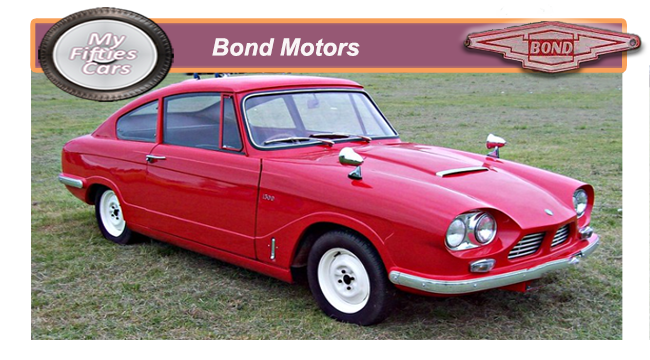 After World War II, an ex-aircraft engineer and inspiring inventor by the name of Lawrence "Laurie" Bond came up with the concept of a low cost, compact vehicle.
After World War II, an ex-aircraft engineer and inspiring inventor by the name of Lawrence "Laurie" Bond came up with the concept of a low cost, compact vehicle.
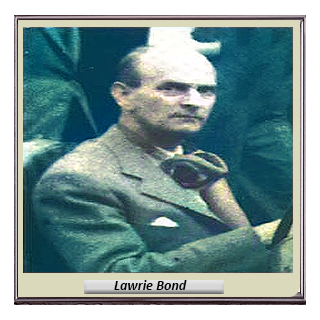 To be known as the Bond Minicar, with a body made of aluminum, and powered by a 122cc motorcycle engine, according to Laurie Bond the Minicar would require only a few simple components to construct and would need very little in the way of production space.
To be known as the Bond Minicar, with a body made of aluminum, and powered by a 122cc motorcycle engine, according to Laurie Bond the Minicar would require only a few simple components to construct and would need very little in the way of production space.
Unfortunately for Bond, production space was very much at a premium in his Longridge factory, situated in the Northwest of England, which was ,in reality, the second story of his home.
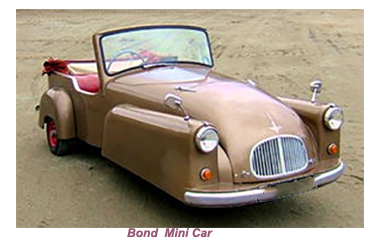 Undeterred, Bond reached out to Sharps Commercials a large engineering concern based in the city of Preston. The people at Sharps like Bond’s concept and reached an agreement to work in tandem to produce the first Minicar.
Undeterred, Bond reached out to Sharps Commercials a large engineering concern based in the city of Preston. The people at Sharps like Bond’s concept and reached an agreement to work in tandem to produce the first Minicar.
According to the agreement, Sharp’s would finance development and handle production of the Minicar with Lawrence Bond acting as a consultant.
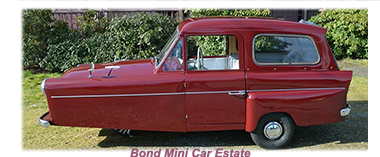 Sharps saw Bond’s proposal as an opportunity to take advantage of a gap in the market that the Minicar could help to fill.
During the post-war era of post-war austerity, low-cost vehicles were very much in demand, although the Bond Mini did have its limitations.
Sharps saw Bond’s proposal as an opportunity to take advantage of a gap in the market that the Minicar could help to fill.
During the post-war era of post-war austerity, low-cost vehicles were very much in demand, although the Bond Mini did have its limitations.
The early versions were capable of reaching just thirty miles per hour and had no reverse gear, meaning that Bond Minicar was at its best on short runs.
In its original design, the engine was attached to the steering fork on the front of the vehicle and the steering wheel. They were only 8-inch-diameter back wheels.
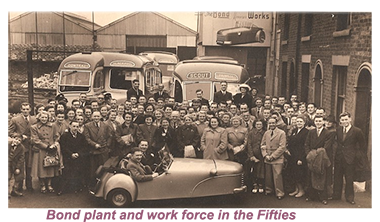 By 1949, the Bond Minicar was in production, with an average of fifteen vehicles produced each week. In the beginning, Minicar was its most basic- a two-seat open tourer with a small trunk behind the seats for luggage. Doorways didn't exist. With the hood up, getting in and out of the vehicle was a challenge.
By 1949, the Bond Minicar was in production, with an average of fifteen vehicles produced each week. In the beginning, Minicar was its most basic- a two-seat open tourer with a small trunk behind the seats for luggage. Doorways didn't exist. With the hood up, getting in and out of the vehicle was a challenge.
 The vehicle was advertised with 100mpg-plus endurance runs. An important factor was that due to the vehicle's three-wheeled design, it was exempt from purchase tax, vehicle excise duty, as well as insurance premiums. The lack of a reverse gear meant that it was completely legal to drive a Bond while holding only a motorcycle license, making it especially attractive to younger drivers.
The vehicle was advertised with 100mpg-plus endurance runs. An important factor was that due to the vehicle's three-wheeled design, it was exempt from purchase tax, vehicle excise duty, as well as insurance premiums. The lack of a reverse gear meant that it was completely legal to drive a Bond while holding only a motorcycle license, making it especially attractive to younger drivers.
![]()
One of the more popular upgrades among Bond followers speed being raised to fifty miles per hour on a variety of models before the end of the protracted production run.
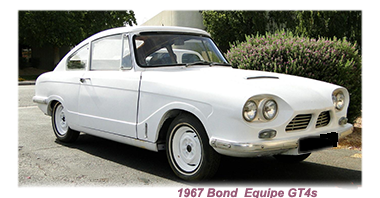 Later models had some form of reverse gear, although to put the vehicle in reverse entailed stopping the engine and restarting it backwards. Bond's Dynastart unit, which served as both a starter and a generator, was reversed to accomplish this.
Later models had some form of reverse gear, although to put the vehicle in reverse entailed stopping the engine and restarting it backwards. Bond's Dynastart unit, which served as both a starter and a generator, was reversed to accomplish this.
On start-up, the Dynastart functioned as a starting motor but when the engine was running it generated electricity and recharged the battery.
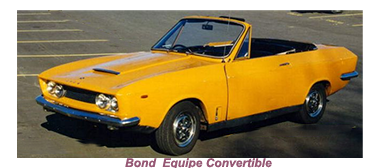 The Mk G range was introduced in September 1961, bringing the Minicar up to date once more with numerous enhancements. A new Villiers 246cc Mk35A engine, trailing arms, coil springs, and hydraulic shock absorbers were added to the rear suspension, and the brakes were updated with a Lockheed hydraulic system. For the Saloon models, a cut-back rear window similar to that fitted on the Ford Anglia, considerably improving visibility.
The Mk G range was introduced in September 1961, bringing the Minicar up to date once more with numerous enhancements. A new Villiers 246cc Mk35A engine, trailing arms, coil springs, and hydraulic shock absorbers were added to the rear suspension, and the brakes were updated with a Lockheed hydraulic system. For the Saloon models, a cut-back rear window similar to that fitted on the Ford Anglia, considerably improving visibility.
The passenger compartment underwent a complete revamp, with the rear seats now capable of fitting two adults comfortably. In 1962 a new Estate model was introduced fitted with a foldable rear seat that could be used for either cargo or passengers and a top-hinged tailgate for easy access.
![]()
Unfortunately, just as the Minicar was reaching the heights in terms of design and all its mechanical foibles had been ironed out, two unforeseen factors emerged that combined to kill off demand for the Minicar in just a few months.
The first was the UK government’s decision in 1961 to raise purchase tax on three-wheel vehicles to virtually the same level as a four-wheel vehicle. The second and possibly more fundamental was the arrival of the BMC Mini from the design studio of Alex Issigonis. The BMC was even more compact than the Mark G, and certainly looked and drove immeasurably better.
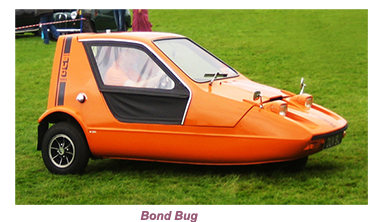 With sales of the Minicar slowing down to a trickle, Bond decided that they should move into producing four wheel cars, coming up with the Equipe GT .
With sales of the Minicar slowing down to a trickle, Bond decided that they should move into producing four wheel cars, coming up with the Equipe GT .
The Bond Equipe GT was a far cry from the Minicar -, a sports car, with fibreglass two door body, fitted on a Triumph Herald chassis, complete with bulkhead, windscreen, and doors, and powered by a Triumph Spitfire 1147 cc engine. Reception for the Equipe GT was lukewarm and it was replaced by the GT4S model in 1964. The GT4S was a four seater sports, powered by a 1296cc engine. In August 1967, Bond introduced a 2 Litre engined version of the Equipe, with principal design coming from Bond's in-house designer, Alan Pounder.
 Reception for the Equipe GT was lukewarm and it was replaced by the GT4S model in 1964. The GT4S was a four seater sports, powered by a 1296cc engine.
Reception for the Equipe GT was lukewarm and it was replaced by the GT4S model in 1964. The GT4S was a four seater sports, powered by a 1296cc engine.
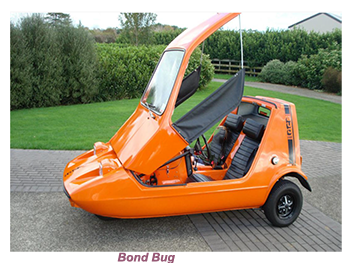 Powered by a 700 cc four-cylinder engine provided by Reliant, the Bug could reach a top speed of 75 mph (121 km/h).
Standing out as a result of its “wedge" body styled by Tom Karen of Ogle Design and bright orange paintwork, the Bug’s roof was designed to swing forward on a front hinge for easy entry.
Powered by a 700 cc four-cylinder engine provided by Reliant, the Bug could reach a top speed of 75 mph (121 km/h).
Standing out as a result of its “wedge" body styled by Tom Karen of Ogle Design and bright orange paintwork, the Bug’s roof was designed to swing forward on a front hinge for easy entry.
 Although the Bug launch in June 1970 was deemed a success, upheavals in the UK car industry at that time were to rebound on Bond, bringing with it considerable financial upheavals
Although the Bug launch in June 1970 was deemed a success, upheavals in the UK car industry at that time were to rebound on Bond, bringing with it considerable financial upheavals
Take me back to the Home Page

